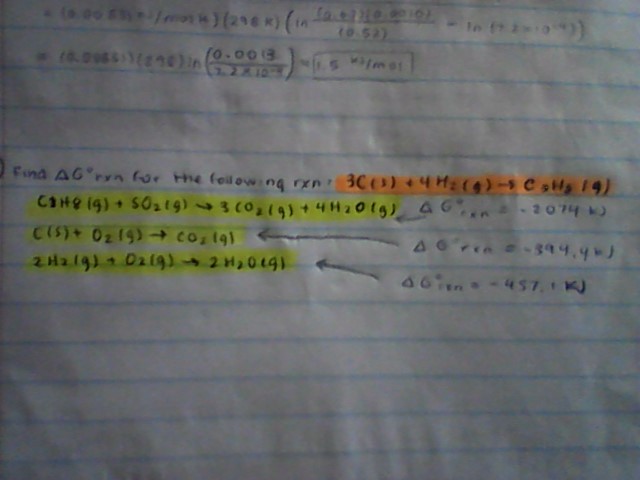Find #\DeltaG°_"rxn"# for the following by using Hess's law with known reactions?
Requested reaction: #3C(s)+4H_2(g)\toC_3H_8(g)#

Requested reaction:

1 Answer
This is just asking you to use Hess's Law (again) for Gibbs' free energy instead of enthalpy. You would not have to do so if you were simply given the table of Gibbs' free energy of formations, so this isn't all that practical.
You are given reactions to flip around and do things with:
#"C"_3"H"_8(g) + 5"O"_2(g) -> 3"CO"_2(g) + 4"H"_2"O"(g)# ,#DeltaG_(rxn,1)^@ = -"2074 kJ/mol"#
#"C"("graphite") + "O"_2(g) -> "CO"_2(g)# ,#DeltaG_(rxn,2)^@ = -"394.4 kJ/mol"#
#2"H"_2(g) + "O"_2(g) -> 2"H"_2"O"(g)# ,#DeltaG_(rxn,3)^@ = -"457.22 kJ/2 mol H"_2"O"(g)#
(Note that the third reaction is not written in a standard manner, and we should note that it is double of a formation reaction.)
Now, we know that we want the formation reaction of propane in the end. Thus, we must
- Flip reaction
#(1)# so that propane shows up in the products with a coefficient of#1# . - Triple reaction
#(2)# , since carbon graphite must be in the reactants with a coefficient of#3# . - Double reaction
#(3)# and otherwise keep it the same, so that#4"H"_2(g)# shows up in the reactants.
The "trick" here is to just match the final reaction. You can literally do this just by honing in on what reactants and what products you want with what coefficients on which side of the reaction, and the rest works itself out.
So, what we do is:
#-("C"_3"H"_8(g) + cancel(5"O"_2(g)) -> cancel(3"CO"_2(g)) + cancel(4"H"_2"O"(g)))# ,#-DeltaG_(rxn,1)^@ = -(-"2074 kJ")#
#3("C"("graphite") + cancel("O"_2(g)) -> cancel("CO"_2(g)))# ,#3DeltaG_(rxn,2)^@ = 3(-"394.4 kJ")#
#ul(2(2"H"_2(g) + cancel("O"_2(g)) -> cancel(2"H"_2"O"(g)))# ,#2DeltaG_(rxn,3)^@ = 2(-"457.22 kJ")#
#3"C"("graphite") + 4"H"_2(g) -> "C"_3"H"_8(g)#
And as you already know, species that are the same on both sides have cancelled. For this then,
#color(blue)(DeltaG_(rxn)^@) = DeltaG_1^@ + DeltaG_2^@ + DeltaG_3^@#
#= -DeltaG_(rxn,1)^@ + 3DeltaG_(rxn,2)^@ + 2DeltaG_(rxn,3)^@#
#= "2074 kJ" - "1183.2 kJ" - "914.44 kJ"#
#= -"23.64 kJ"#
#= color(blue)(-"23.64 kJ/mol propane")#
And this compares well with the literature value below.
This one can also be done by inspection. Once you recognize that carbon graphite solid and dihydrogen gas are the standard states, then this is just the formation reaction to form
#3"C"("graphite") + 4"H"_2(g) -> "C"_3"H"_8(g)#
with:
#DeltaG_(rxn)^@ = DeltaG_f("C"_3"H"_8(g))^@# .
Thus, we can easily check the answer. I find it to be:
#color(blue)(DeltaG_f^@("C"_3"H"_8(g)) = -"24.40 kJ/mol")#

